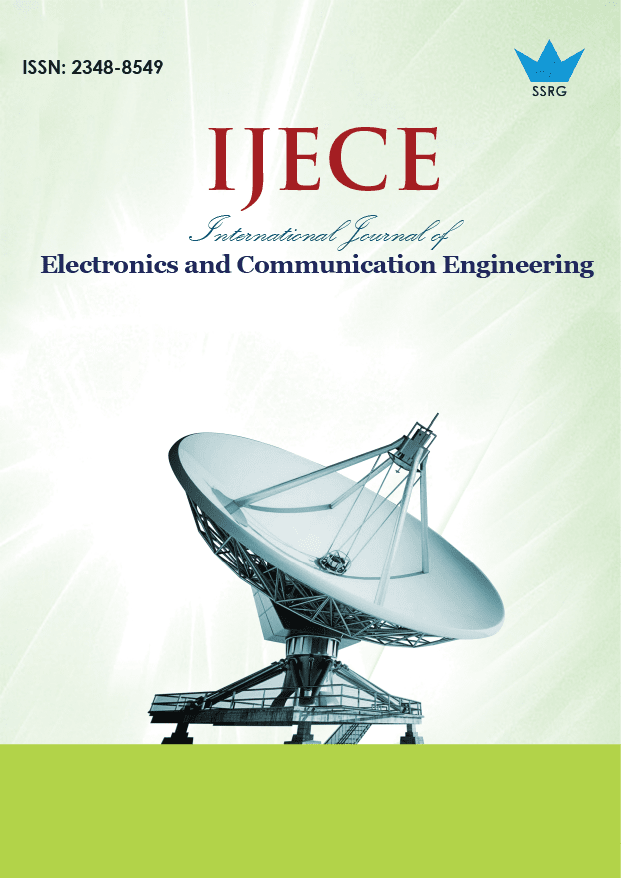Conjugate CRT Based Radar Application for Velocity Estimation of a Wanton Poignant Object Using Synchrocuddling Chriplet Transformation

| International Journal of Electronics and Communication Engineering |
| © 2025 by SSRG - IJECE Journal |
| Volume 12 Issue 6 |
| Year of Publication : 2025 |
| Authors : Bentipalli Sekhar, G.Appala Naidu, K. Babulu |
How to Cite?
Bentipalli Sekhar, G.Appala Naidu, K. Babulu, "Conjugate CRT Based Radar Application for Velocity Estimation of a Wanton Poignant Object Using Synchrocuddling Chriplet Transformation," SSRG International Journal of Electronics and Communication Engineering, vol. 12, no. 6, pp. 29-43, 2025. Crossref, https://doi.org/10.14445/23488549/IJECE-V12I6P103
Abstract:
The Conjugate CRT Based Radar Application for velocity estimation leverages advanced techniques to track a wanton poignant object using Synchrocuddling Chirplet Transformation precisely. This method combines the Conjugate Chinese Remainder Theorem (CRT) with radar signal processing to address phase ambiguities and accurately estimate velocity. Additionally, the effectiveness of the Synchrocuddling Chirplet Transformation depends on accurately capturing and analyzing high-frequency variations, which can be computationally intensive and require precise calibration. Furthermore, integrating the Conjugate Chinese Remainder Theorem (CRT) with radar signal processing adds complexity to the system, potentially leading to increased processing times and the need for robust algorithms to handle modular arithmetic effectively. Addressing these issues is crucial for ensuring accurate and efficient velocity estimation, particularly in dynamic and high-speed tracking scenarios. The paper presents an innovative methodology to retrieve slant range velocity estimates for moving targets, which induce a Dopler-shift beyond the Nyquist limit determined by the Pulse Repetition Frequency (PRF). The implemented method takes advantage of the fact that the range velocity of a moving target induces a Doppler shift in the azimuth spectra, which depends linearly on the fast-time frequency. Finally, an enhanced chirplet transform and synchrosqueezing transform method termed Synchrocuddling Chriplet transformation is proposed to estimate the velocity of a discrete tone source in uniform linear motion. This method directly uses the relation of the observed instantaneous frequency to the source velocity as the moto function of the chirplet transform. Second-order synchrosqueezing transform (SSST) is proposed based on the square of STFT amplitude. Time-frequency resolution and energy aggregation are improved by squeezing and reassigning the time-frequency spectrum. Most of the complicated arithmetic operations are derived using the conjugate CRT process.
Keywords:
Doppler-shift, Synchrosqueezing, Second-order synchrosqueezing transform, Pulse repetition frequency, Synthetic aperture radar, Short-time fourier transform, Residue number system.
References:
[1] Ingrid Daubechies, Jianfeng Lu, and Hau-Tieng Wu, “Synchrosqueezed Wavelet Transform: An Empirical Mode Decomposition-Like Tool,” Applied and Computational Harmonic Analysis, vol. 30, no. 2, pp. 243-261, 2011.
[CrossRef] [Google Scholar] [Publisher Link]
[2] Dominique Fourer, and Geoffroy Peeters, “Fast and Adaptive Blind Audio Source Separation using Recursive Levenberg-Marquardt Synchrosqueezing,” 2018 IEEE International Conference on Acoustics, Speech and Signal Processing (ICASSP), Calgary, AB, Canada, pp. 766-770, 2018.
[CrossRef] [Google Scholar] [Publisher Link]
[3] P. Brundavani, D. Vishnu Vardhan, and B. Abdul Raheem, “Ffsgc-Based Classification of Environmental Factors in IOT Sports Education Data during the Covid-19 Pandemic,” Journal of Sensors, IoT & Health Sciences, vol. 2, no. 1, pp. 28-54, 2024.
[CrossRef] [Google Scholar] [Publisher Link]
[4] Dominique Fourer, and François Auger, “Second-Order Time-Reassigned Synchrosqueezing Transform: Application to Draupner Wave Analysis,” 2019 27th European Signal Processing Conference (EUSIPCO), A Coruna, Spain, pp. 1-5, 2019.
[CrossRef] [Google Scholar] [Publisher Link]
[5] Motofumi Arii, “Efficient Motion Compensation of a Moving Object on SAR Imagery Based on Velocity Correlation Function,” IEEE Transactions on Geoscience and Remote Sensing, vol. 52, no. 2, pp. 936-946, 2024.
[CrossRef] [Google Scholar] [Publisher Link]
[6] Shangyu Liang et al., “Faster-than-Nyquist Precoded CAP Modulation Visible Light Communication System Based on Nonlinear Weighted Look-Up Table Predistortion,” IEEE Photonics Journal, vol. 10, no. 1, pp. 1 -9, 2018.
[CrossRef] [Google Scholar] [Publisher Link]
[7] J. Legg, A. Bolton, and D. Gray, “SAR Moving Target Detection Using Non-Uniform PRI,” The 1st European Conference on Synthetic Aperture Radar, Konigswinter, Germany, pp. 423-426, 1996.
[Google Scholar]
[8] Mehrdad Soumekh, Synthetic Aperture Radar Signal Processing with MATLAB Algorithms, Wiley, pp. 1-616, 1999.
[Google Scholar] [Publisher Link]
[9] P.A.C. Marques, and J.M.B. Dias, “Velocity Estimation of Fast Moving Targets Using Undersampled SAR Raw-Data,” IEEE 2001 International Geoscience and Remote Sensing Symposium, Sydney, NSW, Australia, vol. 4, pp. 1610-1613, 2001.
[CrossRef] [Google Scholar] [Publisher Link]
[10] Yan Xincun et al., “Kalman Filter Applied in Underwater Integrated Navigetion System,” Geodesy and Geodynamics, vol. 4, no. 1, pp. 46-50, 2013.
[CrossRef] [Google Scholar] [Publisher Link]
[11] S. Venkatramulu et al., “Research on SQL Injection Attacks Using Word Embedding Techniques and Machine Learning,” Journal of Sensors, IoT & Health Sciences, vol. 2, no. 1, pp. 55-65, 2024.
[CrossRef] [Google Scholar] [Publisher Link]
[12] W. Zhang et al., “A Study on the Influence between Station Distribution of Netted Radar System and Data Fusion Accuracy,” Modem Radar, vol. 32, no. 7, pp. 11-15, 2010.
[Google Scholar]
[13] Van Cuong Nguyen et al., “Length and Speed Detection Using Microwave Motion Sensor,” 2014 International Conference on Advanced Technologies for Communications (ATC 2014), Hanoi, Vietnam, pp. 371-376, 2014.
[CrossRef] [Google Scholar] [Publisher Link]
[14] S.A. Daud et al., “Application of Infrared Sensor for Shape Detection,” 2013 IEEE 4th International Conference on Photonics (ICP), Melaka, Malaysia, pp. 145-147, 2013.
[CrossRef] [Google Scholar] [Publisher Link]
[15] H.T. Chan, T.A Rahman, and A. Arsad, “Performance Study of Virtual Fence Unit Using Wireless Sensor Network in IoT Environment,” 2014 20th IEEE International Conference on Parallel and Distributed Systems (ICPADS), Hsinchu, Taiwan, pp. 873-875, 2014.
[CrossRef] [Google Scholar] [Publisher Link]
[16] Muhammad Asad Khan, Sajid Saleem, and Amir A. Khan, “CRT Based Spectral Convolution in Binary Fields.” Arxiv, pp. 1-14, 2019.
[CrossRef] [Google Scholar] [Publisher Link]

 10.14445/23488549/IJECE-V12I6P103
10.14445/23488549/IJECE-V12I6P103